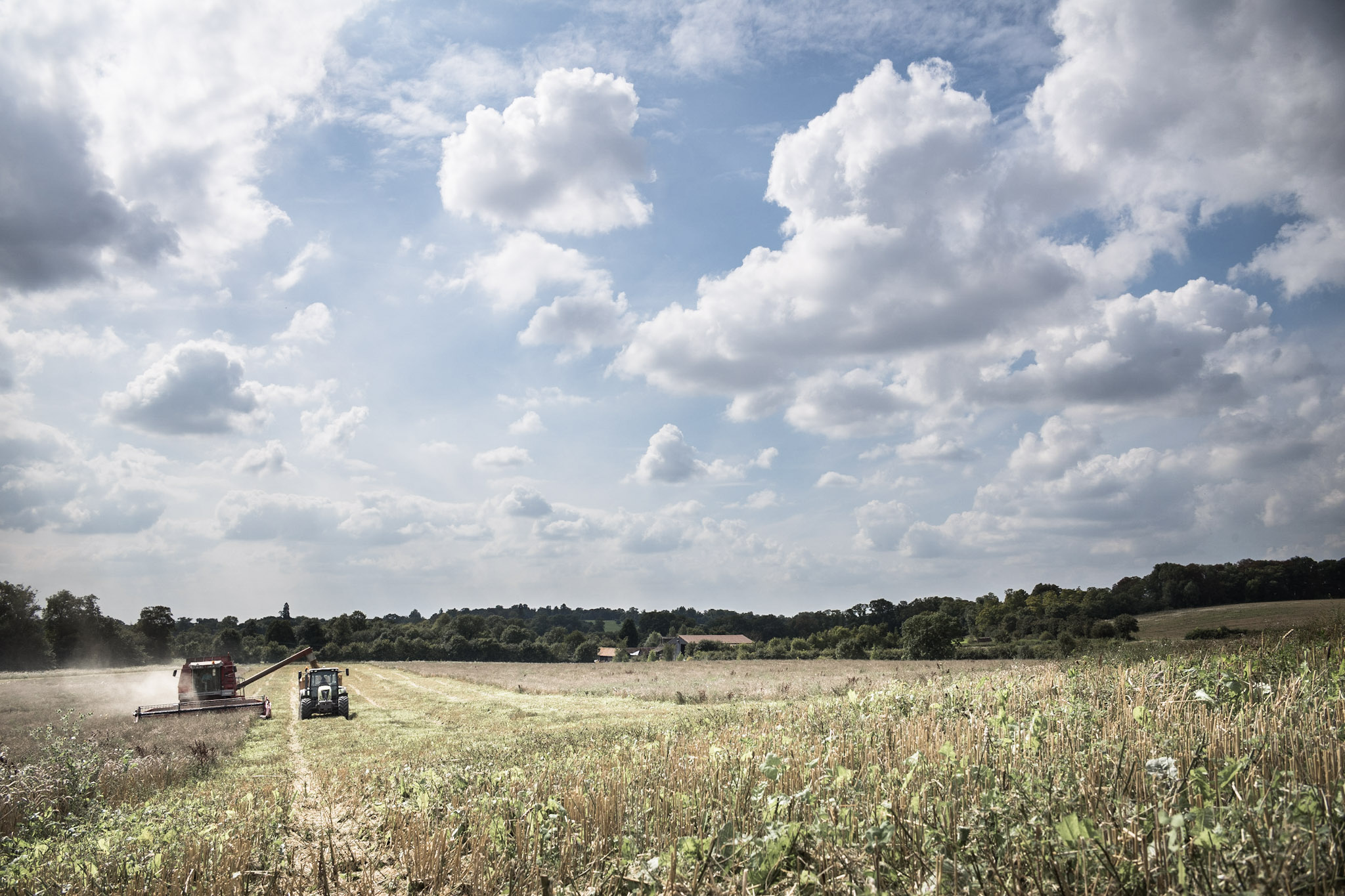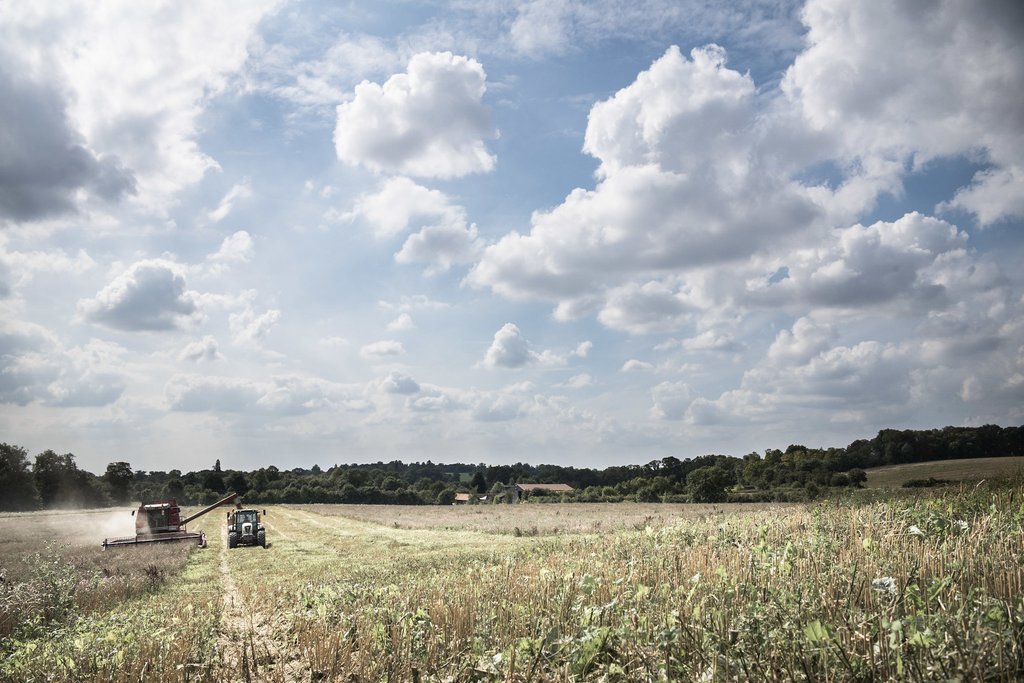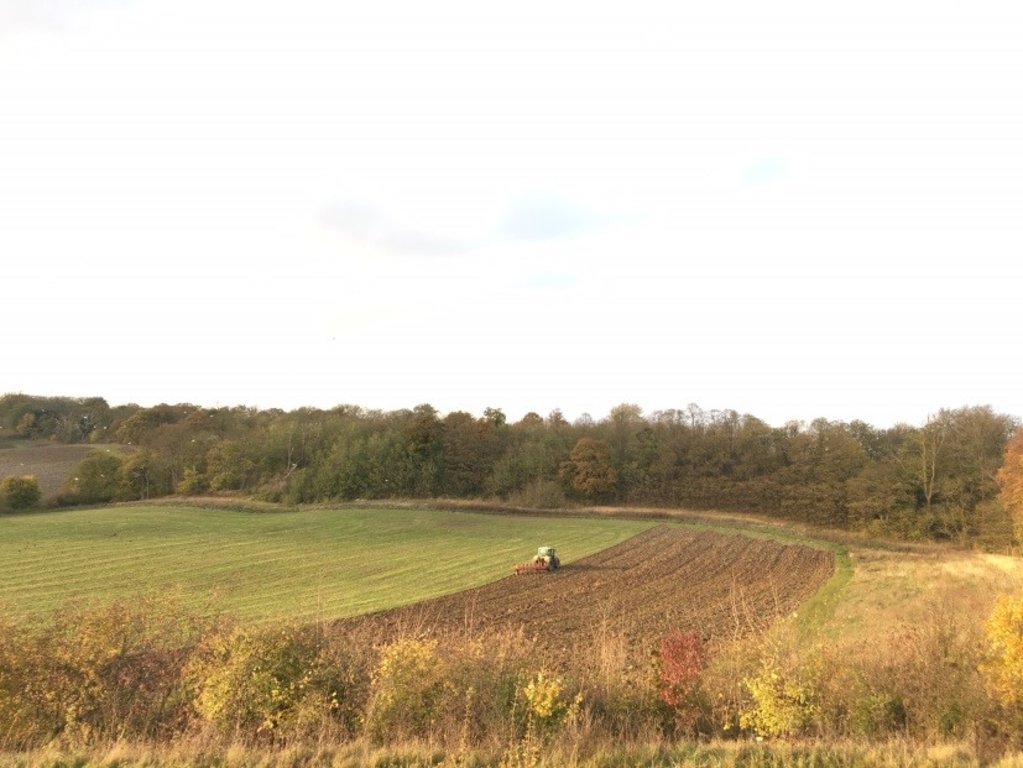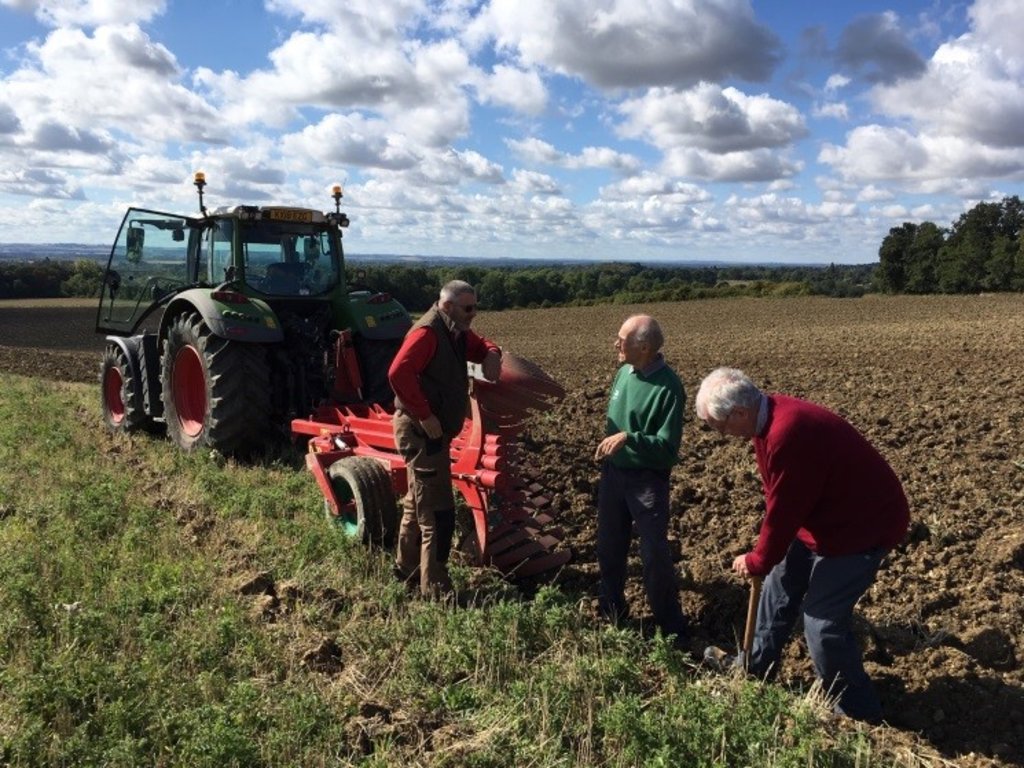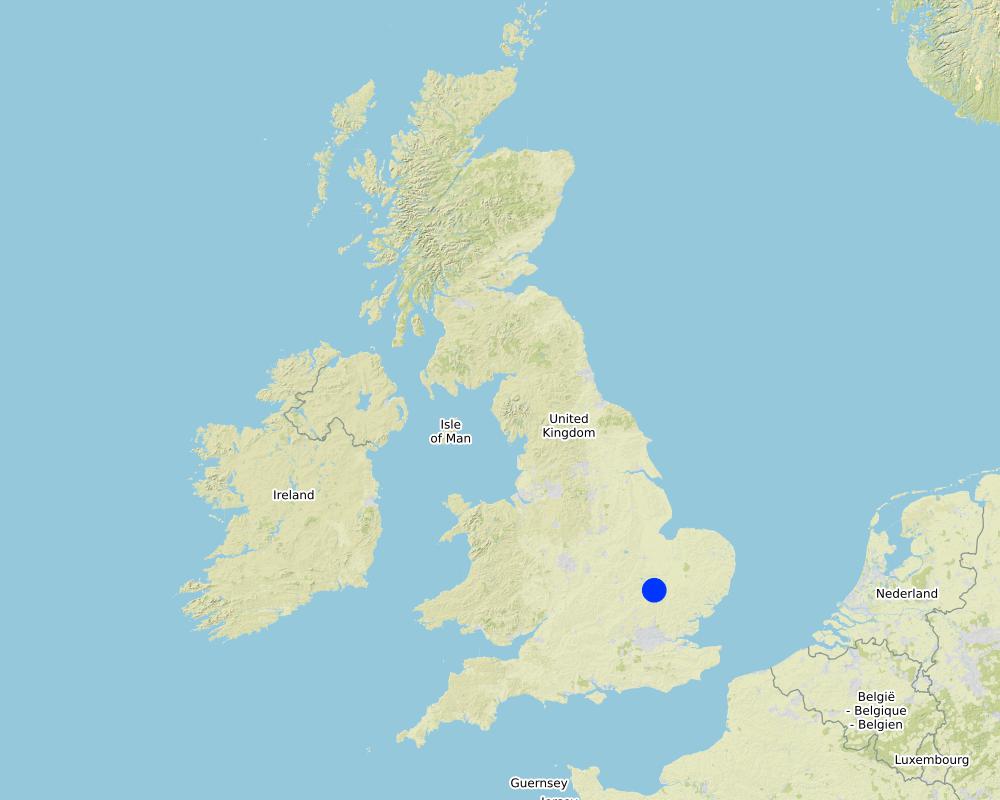Reduced tillage - Non-inversion and shallow cultivation in organic systems [英国]
- 创建:
- 更新:
- 编制者: Sabine Reinsch
- 编辑者: David Robinson
- 审查者: Renate Fleiner
Non-inversion and shallow cultivation in organic systems
technologies_5012 - 英国
查看章节
全部展开 全部收起1. 一般信息
1.2 参与该技术评估和文件编制的资源人员和机构的联系方式
关键资源人
土地使用者:
Weir Callum
The National Trust
英国
有助于对技术进行记录/评估的项目名称(如相关)
European Interreg project FABulous Farmers有助于对技术进行记录/评估的机构名称(如相关)
UK Centre for Ecology & Hydrology (CEH) - 英国有助于对技术进行记录/评估的机构名称(如相关)
The National Trust (National Trust) - 英国1.3 关于使用通过WOCAT记录的数据的条件
编制者和关键资源人员接受有关使用通过WOCAT记录数据的条件。:
是
1.4 所述技术的可持续性声明
这里所描述的技术在土地退化方面是否存在问题,导致无法被认为是一种可持续的土地管理技术?:
否
2. SLM技术的说明
2.1 技术简介
技术定义:
Non-inversion and ‘shallow’ ploughing cultivation strategies on an organic farm, where the use of herbicides for weed control is prohibited.
2.2 技术的详细说明
说明:
The shallow plough is used on land dominated by clay soils at an organically farmed estate, south of Cambridgeshire, UK. Previously, ‘conventional’ ploughs were used, which plough deeper than a shallow plough. However, ploughing deeper would often bring large chunks of raw clay from the subsoil to the surface. This would quickly solidify, locally referred as when the soil turns to ‘concrete’. Numerous cultivations were then required to reduce these ‘concrete’ soil chunks into a seed bed. It was a laborious, expensive task which sacrificed soil health to produce a less than satisfactory result. However, the farm still required a plough of some form as a means of weed control through inversion. As it is an organic estate, chemical sprays could not be used. A shallow plough was invested in as a way of striking the balance between overcoming the problems of creating a seedbed, but also maintaining the weed control benefits of inversion tillage. It has been very successful in reducing the input requirements, and at the same time increasing the quality of the output. Whilst shallow ploughing has challenges, such as full inversion of weeds in very dry conditions, on balance it is much better for the farming business than the previous alternative. We are able to do less damage to soil, and increase outputs which is important due to agricultural labour scarcity and smaller weather windows due to climate change.
Reduced tillage options have been a challenge to combat in organic systems where herbicides are prohibited. As such, trials of reduced tillage options have been explored. These include;
1)Non-inversion tillage where no ploughing is done and soil is cultivated to the first 100 mm.
2)Shallow ploughing where a specifically designed plough inverts soil to a depth of 125 mm, as opposed to traditional plough depths of 200 mm.
The purpose of this technology is to minimise soil disturbance to enhance the soil structure, biology and chemistry, whilst creating a seed bed and controlling weeds. The challenge on the specific site is there has been a history of annual plough, which has led to the proliferation of weeds that thrive on such systems. These include creeping thistle and common docks. As such, there was also the purpose of ‘disrupting’ the existing system in order to control these weeds. The only specific input required was a shallow plough, designed to invert soil from lower depths. For non-inversion tillage, a subsoiler and disc cultivator were used. The non-inversion tillage was done at two sites; one cereal stubble and one out of a fertility building two-year grass and clover ley.
Benefits/impacts/things land owners did/did not like:
Non-inversion tillage:
-Instead of ploughing, non-inversion tillage from the fertility ley allowed us to keep the soil structure from 2 years of grass/clover intact and in the right soil profile. We weren’t burying the friable, high-nutrient and porous top soil 200 mm under the ground and we weren’t lifting heavy, lower-aerobic soil to the surface where we wanted to plant.
-This meant that plants established quicker and we were able to drill later, despite the fields being very heavy, poorly drained fields.
-Weeds were killed, primarily through timely cultivations during a hot-spell, so that the cultivator brought roots to the surface to dry them.
-Drainage was evident after drilling as we were able to graze sheep on the wheat in March.
-Crops have tillered well and responded to nutrients.
-Establishment costs were approximately £30/ha cheaper.
-However, non-inversion tillage in cereal stubbles has not been as successful due to weed control, and whether the cheaper costs outweighs the weed burden remains to be assessed. The reason for this is not being able to cultivate during the hot weather (as this came before harvest).
-In addition, in cereal stubbles, we have seen less creeping thistles and docks, but more wild oats and cereal volunteers.
Shallow ploughing:
-Cheaper establishment costs through lower diesel usage (yet to be quantified).
-Better in many circumstances of inverting soil completely, but from a much lower depth.
-Did not bring up any large clumps of sub-soil which the conventional plough would. These result in much cultivations to break the clumps down.
-Ploughing ‘on-land’ meant that there was no smearing in the furrow from tyres.
-Lower HP requirement – 180 hp tractor ploughing 3.2 m to 125 mm on heavy land.
-Ploughing left over-winter did not require more than one cultivation before drilling as ploughed soil was friable from lower plough depth.
-That being said, there were favourable ploughing conditions in 2018. Regardless, we have sold our conventional plough because we like the shallow plough so much.
General benefits are:
-Reduced, prevented or restored land degradation
-Improved/preserved biodiversity
-Increased adaptation/resilience to climate change/extremes and its impacts
-A potential beneficial economic impact
The compilation of this SLM is a part of the European Interreg project FABulous Farmers which aims to reduce the reliance on external inputs by encouraging the use of methods and interventions that increase the farm’s Functional AgroBiodiversity (FAB). Visit www.fabulousfarmers.eu and www.nweurope.eu/Fabulous-Farmers for more information.
2.3 技术照片
2.5 已应用该技术的、本评估所涵盖的国家/地区/地点
国家:
英国
有关地点的进一步说明:
Wimpole Estate
具体说明该技术的分布:
- 均匀地分布在一个区域
如果技术均匀分布在一个区域,则指定覆盖的区域(单位为平方千米):
4.0
如果不知道精确的区域,请注明大致覆盖的区域:
- 1-10 平方千米
技术现场是否位于永久保护区?:
否
Map
×2.6 实施日期
注明实施年份:
2018
如果不知道确切的年份,请说明大概的日期:
- 不到10年前(最近)
2.7 技术介绍
详细说明该技术是如何引入的:
- 通过土地使用者的创新
注释(项目类型等):
Hosted on a demonstration farm, so able to take more risks. The ideas were adapted from other farmer’s ideas. Some of these principles have not been tried much in organic systems, which is why they are unique. However, they are becoming more commonplace in conventional systems.
3. SLM技术的分类
3.1 该技术的主要目的
- 减少、预防、恢复土地退化
- 保持/提高生物多样性
- 适应气候变化/极端天气及其影响
- 减缓气候变化及其影响
- 创造有益的经济影响
3.2 应用该技术的当前土地利用类型
同一土地单元内混合使用的土地::
否

农田
- 一年一作
年作 - 具体指明作物:
- 谷类 - 其他
- 饲料作物 - 三叶草
- 饲料作物 - 草
每年的生长季节数:
- 1
采用间作制度了吗?:
是
采用轮作制度了吗?:
否
3.3 由于技术的实施,土地使用是否发生了变化?
由于技术的实施,土地使用是否发生了变化?:
- 否(继续问题3.4)
同一土地单元内混合使用的土地::
否
3.4 供水
该技术所应用土地的供水:
- 雨养
3.5 该技术所属的SLM组
- 最小的土壤扰动
- 土壤肥力综合管理
- 引水和排水
3.6 包含该技术的可持续土地管理措施

农艺措施
- A3:土壤表面处理
- A5:种子管理,改良品种
A3:区分耕作制度:
A 3.2: Reduced tillage (> 30% soil cover)
3.7 该技术强调的主要土地退化类型

土壤风蚀
- Et:表土流失

化学性土壤退化
- Cn:肥力下降和有机质含量下降(非侵蚀所致)

物理性土壤退化
- Pc:压实

生物性退化
- Bs:质量和物种组成/多样性的下降
- Bp:害虫/疾病增加,捕食者减少

水质恶化
- Hs:地表水良变化
- Hg:地下水/含水层水位的变化
- Hq:地下水水质下降
- Hw:湿地缓冲能力下降
3.8 防止、减少或恢复土地退化
具体数量名该技术与土地退化有关的目标:
- 防止土地退化
- 减少土地退化
4. 技术规范、实施活动、投入和成本
4.2 有关投入和成本计算的一般信息
具体说明成本和投入是如何计算的:
- 每个技术区域
注明尺寸和面积单位:
4 ha
如果使用本地面积单位,注明转换系数为1公顷(例如1公顷=2.47英亩):1公顷=:
Approx. £45/ha – about 25% less than ‘deep ploughing’
其它/国家货币(具体说明):
GBP
如相关,注明美元与当地货币的汇率(例如1美元=79.9巴西雷亚尔):1美元=:
0.82
注明雇用劳工的每日平均工资成本:
£90
4.3 技术建立活动
| 活动 | 时间(季度) | |
|---|---|---|
| 1. | Use of shallow plough | After harvest |
4.4 技术建立所需要的费用和投入
| 对投入进行具体说明 | 单位 | 数量 | 单位成本 | 每项投入的总成本 | 土地使用者承担的成本% | |
|---|---|---|---|---|---|---|
| 劳动力 | Person per day | person day | 1.0 | 90.0 | 90.0 | 100.0 |
| 设备 | Ovlac Shallow Plough (7+1f) (one off) | 1 | 1.0 | 11000.0 | 11000.0 | 100.0 |
| 设备 | Tractor | per day | 1.0 | 180.0 | 180.0 | 100.0 |
| 其它 | Diesel (120 litres per day) | ltrs per day | 1.0 | 60.0 | 60.0 | 100.0 |
| 技术建立所需总成本 | 11330.0 | |||||
| 技术建立总成本,美元 | 13817.07 | |||||
4.5 维护/经常性活动
| 活动 | 时间/频率 | |
|---|---|---|
| 1. | Grease plough | once per week |
| 2. | change plough points | once per season |
4.7 影响成本的最重要因素
描述影响成本的最决定性因素:
Most important factors affecting cost are decreased time spent ploughing and lower diesel cost, reducing establishment costs by £15 per ha.
5. 自然和人文环境
5.1 气候
年降雨量
- < 250毫米
- 251-500毫米
- 501-750毫米
- 751-1,000毫米
- 1,001-1,500毫米
- 1,501-2,000毫米
- 2,001-3,000毫米
- 3,001-4,000毫米
- > 4,000毫米
有关降雨的规范/注释:
Highest rainfall month is August, which is important as this is when cultivations need to occur. As non-inversion and shallow ploughing are faster operations, this means that cultivations can occur at more optimum times.
农业气候带
- 半湿润
5.2 地形
平均坡度:
- 水平(0-2%)
- 缓降(3-5%)
- 平缓(6-10%)
- 滚坡(11-15%)
- 崎岖(16-30%)
- 陡峭(31-60%)
- 非常陡峭(>60%)
地形:
- 高原/平原
- 山脊
- 山坡
- 山地斜坡
- 麓坡
- 谷底
垂直分布带:
- 0-100 m a.s.l.
- 101-500 m a.s.l.
- 501-1,000 m a.s.l.
- 1,001-1,500 m a.s.l.
- 1,501-2,000 m a.s.l.
- 2,001-2,500 m a.s.l.
- 2,501-3,000 m a.s.l.
- 3,001-4,000 m a.s.l.
- > 4,000 m a.s.l.
说明该技术是否专门应用于:
- 不相关
5.3 土壤
平均土层深度:
- 非常浅(0-20厘米)
- 浅(21-50厘米)
- 中等深度(51-80厘米)
- 深(81-120厘米)
- 非常深(> 120厘米)
土壤质地(表土):
- 细粒/重质(粘土)
土壤质地(地表以下> 20厘米):
- 细粒/重质(粘土)
表土有机质:
- 高(>3%)
如有可能,附上完整的土壤描述或具体说明可用的信息,例如土壤类型、土壤酸碱度、阳离子交换能力、氮、盐度等。:
Gault clay/Hanslope clay, pH 7.5
5.4 水资源可用性和质量
地下水位表:
< 5米
地表水的可用性:
中等
水质请参考::
地下水和地表水
水的盐度有问题吗?:
否
该区域正在发生洪水吗?:
否
5.5 生物多样性
物种多样性:
- 高
栖息地多样性:
- 高
5.6 应用该技术的土地使用者的特征
定栖或游牧:
- 定栖的
生产系统的市场定位:
- 商业/市场
非农收入:
- 低于全部收入的10%
相对财富水平:
- 平均水平
个人或集体:
- 个人/家庭
机械化水平:
- 机械化/电动
性别:
- 男人
土地使用者的年龄:
- 中年人
- 老年人
5.7 应用该技术的土地使用者使用的平均土地面积
- < 0.5 公顷
- 0.5-1 公顷
- 1-2 公顷
- 2-5公顷
- 5-15公顷
- 15-50公顷
- 50-100公顷
- 100-500公顷
- 500-1,000公顷
- 1,000-10,000公顷
- > 10,000公顷
这被认为是小规模、中规模还是大规模的(参照当地实际情况)?:
- 中等规模的
5.8 土地所有权、土地使用权和水使用权
土地所有权:
- 个人,有命名
土地使用权:
- 租赁
- 个人
土地使用权是否基于传统的法律制度?:
是
5.9 进入服务和基础设施的通道
健康:
- 贫瘠
- 适度的
- 好
教育:
- 贫瘠
- 适度的
- 好
技术援助:
- 贫瘠
- 适度的
- 好
就业(例如非农):
- 贫瘠
- 适度的
- 好
市场:
- 贫瘠
- 适度的
- 好
能源:
- 贫瘠
- 适度的
- 好
道路和交通:
- 贫瘠
- 适度的
- 好
饮用水和卫生设施:
- 贫瘠
- 适度的
- 好
金融服务:
- 贫瘠
- 适度的
- 好
6. 影响和结论性说明
6.1 该技术的现场影响
社会经济效应
生产
作物生产
作物质量
饲料生产
注释/具体说明:
Crop quality before SLM not able to handle grazing, but now can graze so large increase in fodder/animal production compared to previous model
畜牧生产
注释/具体说明:
Crop quality before SLM not able to handle grazing, but now can graze so large increase in fodder/animal production compared to previous model
土地管理
收入和成本
农业投入费用
农业收入
收入来源的多样性
工作量
其它社会经济效应
work/life balance
社会文化影响
娱乐机会
SLM/土地退化知识
生态影响
水循环/径流
水的回收/收集
地表径流
多余水的排放
土壤
土壤水分
土壤覆盖层
土壤流失
土壤结壳/密封
土壤压实
养分循环/补给
土壤有机物/地下C
生物多样性:植被、动物
植被覆盖
生物量/地上C
外来入侵物种
动物多样性
有益物种
害虫/疾病控制
注释/具体说明:
A small decrease in disease control with shallow ploughing is not as effective as inverting with a conventional plough. This is because less of the stubble from the previous crop would be inverted, creating a greater chance of disease carryover, for example Septoria nodorum blotch.
减少气候和灾害风险
洪水影响
干旱影响
6.2 该技术的场外影响已经显现
旱季稳定可靠的水流
下游洪水
下游淤积
地下水/河流污染
缓冲/过滤能力
风力搬运沉积物
温室气体的影响
6.3 技术对渐变气候以及与气候相关的极端情况/灾害的暴露和敏感性(土地使用者认为的极端情况/灾害)
渐变气候
渐变气候
| 季节 | 增加或减少 | 该技术是如何应对的? | |
|---|---|---|---|
| 年温度 | 增加 | 好 | |
| 季节性温度 | 春季 | 增加 | 好 |
| 年降雨量 | 减少 | 适度 | |
| 季雨量 | 春季 | 减少 | 好 |
气候有关的极端情况(灾害)
气象灾害
| 该技术是如何应对的? | |
|---|---|
| 局地暴雨 | 适度 |
| 局地雷暴 | 适度 |
气候灾害
| 该技术是如何应对的? | |
|---|---|
| 热浪 | 适度 |
| 干旱 | 适度 |
其他气候相关的后果
其他气候相关的后果
| 该技术是如何应对的? | |
|---|---|
| 延长生长期 | 好 |
| 缩短生长期 | 好 |
6.4 成本效益分析
技术收益与技术建立成本相比如何(从土地使用者的角度看)?
短期回报:
稍微积极
长期回报:
积极
技术收益与技术维护成本/经常性成本相比如何(从土地使用者的角度看)?
短期回报:
中性/平衡
长期回报:
稍微积极
6.5 技术采用
- 单例/实验
在所有采用这项技术的人当中,有多少人是自发的,即未获得任何物质奖励/付款?:
- 51-90%
注释:
No govt. or private incentive for reduced tillage.
6.6 适应
最近是否对该技术进行了修改以适应不断变化的条件?:
否
6.7 该技术的优点/长处/机会
| 土地使用者眼中的长处/优势/机会 |
|---|
| Cheaper establishment costs and quicker establishment time mean it will benefit the farm in the long term as labour becomes an issue (regardless of Brexit). |
| Makes soil more resilient to changing weather conditions, both drier and wetter conditions. |
| Reduced soil carbon emissions and diesel emissions from tractor. |
| Better soil structure, biology and chemistry to boost yield, plus allows us to use plough sparingly as a ‘reset’ button when we really need to. |
| However, there is a risk to yield if not used correctly. Plus, we may solve one weed issue (thistles and docks) and move to another weed issue (cereal volunteers, blackgrass and wild oats). |
6.8 技术的弱点/缺点/风险及其克服方法
| 土地使用者认为的弱点/缺点/风险 | 如何克服它们? |
|---|---|
| We may solve one weed issue (thistles and docks) and move to another weed issue (cereal volunteers, blackgrass and wild oats). |
- Use dry June/July to non-invert fertility leys, allowing plough to be used as a reset button later in the rotation. - Minimise non-inversion in cereal stubbles to cleanest crops. |
| Management demand to adapt technology to annual changes in conditions (not as easy as ploughing or spraying in any conditions – to do this, you must be adaptable). |
-Operator education -Planning |
7. 参考和链接
7.1 信息的方法/来源
- 与土地使用者的访谈
Sharing of other ideas on twitter from other farmers.
链接和模块
全部展开 全部收起链接
无链接
模块
无模块


